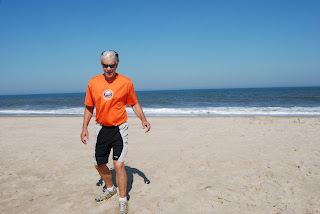As the photo indicates I began Easter with my own sunrise service and spent most of the remainder of the pre-church morning catching up on the blog.
I am sure we displaced someone from their normal seat in the third row of the Lewes Presbyterian Church where the average age of the congregants appeared to be just slightly less than the average in Presbyterian churches throughout the USA – which I think is about 71.2.
Seriously, the joys and concerns section of the service was dominated by prayers for people who had broken something in a fall.
“Be careful walking out of here,” I whispered to Betsy, “we could be next.”
By Lewes standards the sanctuary at Lewes Presbyterian is fairly modern and it is the third sanctuary built on the current site…in 1832.
The Presbyterians were rightfully proud of having raised $1.9 million for the restoration (a factoid the preacher artfully tied into his Easter message, which he carefully read word for word from a prepared text without the aid of a teleprompter).
Also, to be fair, I should mention that there were two other services held Sunday at Lewes Presbyterian. The one we attended was the “traditional” service at 11 a.m. and it likely attracted the older folks among Lewes Presbyterian’s 300 members (at least, let's hope so).
Besides Presbyterians there is a lot of other stuff in Lewes that is really old.
Lewes was “discovered” by no less an exploratory luminary than Henry Hudson himself, in 1609. Because it has a natural harbor the Dutch established a whaling station here but that didn’t last too long. All 32 inhabitants were killed in a tiff with some of the locals who apparently took exception to Mr. Hudson’s “discovery”.
Lewes was “discovered” by no less an exploratory luminary than Henry Hudson himself, in 1609. Because it has a natural harbor the Dutch established a whaling station here but that didn’t last too long. All 32 inhabitants were killed in a tiff with some of the locals who apparently took exception to Mr. Hudson’s “discovery”.
The English soon displaced the Dutch and, in 1682, the “lower counties of the Delaware (river)” were conveyed to William Penn who named the little spot with the natural harbor at the point where the Delaware River meets the Atlantic Ocean “Lewes”, in honor of a town in Sussex County, England. (Note: Lewes, DE is also in Sussex County. What an odd coincidence?).
As the cannonball that is still stuck in the side of one of the downtown buildings – fired from a British frigate during the War of 1812 – attests, Lewes has had its share of troubles with foreigners over the years.
After a scrumptious dinner we took off on our bikes to tour a site that was developed specifically to repel foreign invasion, nearby Henlopen State Park. Before becoming a park the Henlopen peninsula served as a Navy guard post protecting the Delaware Bay from German warships in World War II.
Apparently it worked. In 1942 a German U-boat was captured just off the coast of Lewes.
Soon after the war technological advances in missal defense made the base obsolete and the hundreds of acres of concrete bunkers, watchtowers and barracks were turned over to the state in 1964.
My, my what a fantastic park facility it has become. There are miles of pristine beaches, sand dunes and stands of pine trees interconnected with roads and hike and bike trails that, for the most part, use the remnants of the military’s road system. One of the concrete watchtowers is still open and you can climb the spiral staircase inside for a fantastic view of everything from Rehoboth Beach to Lewes and – on a clear day – across the bay to New Jersey.
On the ride home we explored a section of Lewes we had not yet been to but it was just more of the same old same old – quaint street after quaint street lined with impeccably maintained historic homes. I think Lewes may be the nicest “beach town” I’ve ever seen (of course, being from Texas, that is not necessarily much of a compliment).




2 comments:
I must admit, inspite of being a "sensitive Presbyterian," that I am enjoying reading the daily blogs. I do expect that you will attend the other Sunday services so that you have a more representative sample of the worship experience. You also happened to be at church on Easter Sunday, which probably has, after Christmas, the highest attendance of worshipers. In any case, I am happy that I fit the age profile of those in the congregation. Don't forget that God likes seniors. In Genesis 12:4 we read that Abram was 74 years old when God called him to leave his home of Herran and "set out as the Lord had bidden him."
John, I think it is worth noting that one of the likely reasons (perhaps the primary reason) that Abram was so spry at such an advanced age is that he had a very attractive (and presumably much younger) wife. So much so that he was able to pass her off as his sister!
Betsy and I will have to sit out on the deck tonight staring out at the Atlantic while sipping a Dogfish Head Shelter Pale Ale or two and try to contemplate the true meaning of God's message in Genesis 12.
Post a Comment